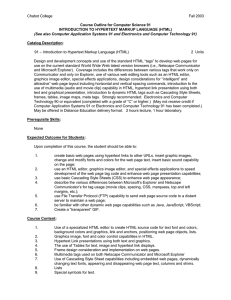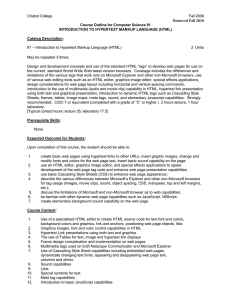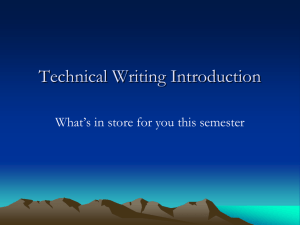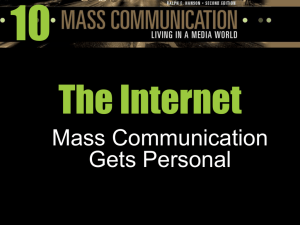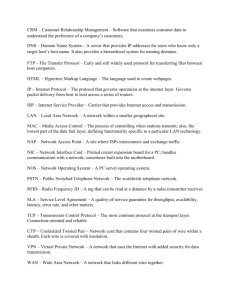Chabot College Fall 2003 Course Outline for Computer Application Systems 91
advertisement
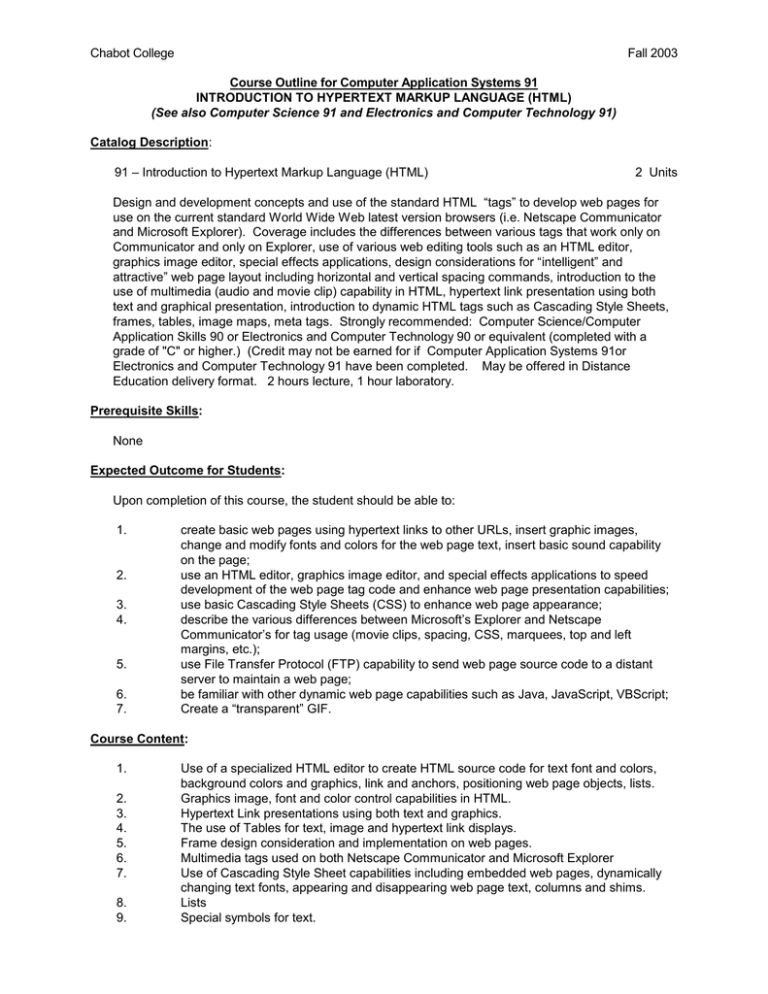
Chabot College Fall 2003 Course Outline for Computer Application Systems 91 INTRODUCTION TO HYPERTEXT MARKUP LANGUAGE (HTML) (See also Computer Science 91 and Electronics and Computer Technology 91) Catalog Description: 91 – Introduction to Hypertext Markup Language (HTML) 2 Units Design and development concepts and use of the standard HTML “tags” to develop web pages for use on the current standard World Wide Web latest version browsers (i.e. Netscape Communicator and Microsoft Explorer). Coverage includes the differences between various tags that work only on Communicator and only on Explorer, use of various web editing tools such as an HTML editor, graphics image editor, special effects applications, design considerations for “intelligent” and attractive” web page layout including horizontal and vertical spacing commands, introduction to the use of multimedia (audio and movie clip) capability in HTML, hypertext link presentation using both text and graphical presentation, introduction to dynamic HTML tags such as Cascading Style Sheets, frames, tables, image maps, meta tags. Strongly recommended: Computer Science/Computer Application Skills 90 or Electronics and Computer Technology 90 or equivalent (completed with a grade of "C" or higher.) (Credit may not be earned for if Computer Application Systems 91or Electronics and Computer Technology 91 have been completed. May be offered in Distance Education delivery format. 2 hours lecture, 1 hour laboratory. Prerequisite Skills: None Expected Outcome for Students: Upon completion of this course, the student should be able to: 1. 2. 3. 4. 5. 6. 7. create basic web pages using hypertext links to other URLs, insert graphic images, change and modify fonts and colors for the web page text, insert basic sound capability on the page; use an HTML editor, graphics image editor, and special effects applications to speed development of the web page tag code and enhance web page presentation capabilities; use basic Cascading Style Sheets (CSS) to enhance web page appearance; describe the various differences between Microsoft’s Explorer and Netscape Communicator’s for tag usage (movie clips, spacing, CSS, marquees, top and left margins, etc.); use File Transfer Protocol (FTP) capability to send web page source code to a distant server to maintain a web page; be familiar with other dynamic web page capabilities such as Java, JavaScript, VBScript; Create a “transparent” GIF. Course Content: 1. 2. 3. 4. 5. 6. 7. 8. 9. Use of a specialized HTML editor to create HTML source code for text font and colors, background colors and graphics, link and anchors, positioning web page objects, lists. Graphics image, font and color control capabilities in HTML. Hypertext Link presentations using both text and graphics. The use of Tables for text, image and hypertext link displays. Frame design consideration and implementation on web pages. Multimedia tags used on both Netscape Communicator and Microsoft Explorer Use of Cascading Style Sheet capabilities including embedded web pages, dynamically changing text fonts, appearing and disappearing web page text, columns and shims. Lists Special symbols for text. Chabot College Course Outline for Computer Application Systems 91, Page 2 Fall 2003 Course Content: continued 10. 11. 12. FTP using a specialized application. Introduction to basic JavaScript and VBScript capabilities. Meta tag capabilities. Methods of Presentation: 1. 2. 3. 4. 5. Lecture via DVD or VHS tapes Discussion via Blackboard chat room capability Demonstrations from DVD/VHS tapes Reading assignments from assigned text Research on the web Assignments and Methods of Evaluating Student Progress: 1. Typical assignments a. Build the frame-work for your Website b. Create at least 2 Menus with at least 3 hyperlink text jump prompts each under each of the main menu text. The Javascript code should do the following: 1) When the cursor moves over the main menu text, the submenu items appear. 2) When you move the mouse off the submenu items, those menu items disappear 3) You will want to use the block and none in a style display for the objects. Name the objects under the DIV or SPAN. 2. Methods of Evaluating Student Progress a. Written quizzes and a final exam on Blackboard b. Lab assignments creating student web pages emphasizing certain features and capabilities as presented in the course content on Blackboard Textbook(s) Typical: New Perspectives on Creating web Page for HTML, by Carey, Thompson-Course Technology Publishing, 2002 Special Student Materials: Diskette New October 1996, Desmond Chun Revised December 1998 CS, Revised 11/99 for D.E. Revised Fall 2002, Effective 2003
